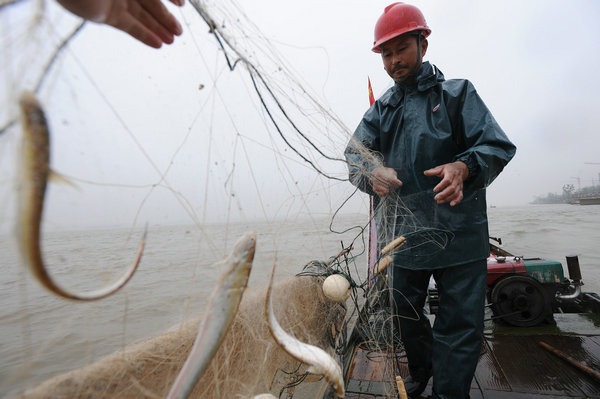 |
|
A fisherman harvests the knife fish along the Yangtze. [Photo provided to China Daily] |
Huaiyang speciality
Hou Xinqing, one of the most recognized chefs cooking Huaiyang cuisine in China, believes the renewed interest in the knife fish signals a revival of Huaiyang cuisine, the most overlooked among China's four pillar cuisines.
For centuries, it's been known for using the best ingredients of each season, month by month, and staying true to their original taste. Developed and funded by China's richest salt merchants centuries ago, its simplicity demands great technique from the chef.
"It's not like the spicy Sichuan cuisine, which is like a bomb on the tongue," says Hou.
"It takes time and perhaps wealth as well to appreciate the light and delightful Huaiyang cuisine."
Hou is a protege of Zhou Xiaoyan, China's master chef of the cuisine who is now also leading the delegation to get Huaiyang cuisine listed by UNESCO as an intangible cultural heritage.
As people's earnings have improved, Hou says he has witnessed a revived interest in East China's cuisine, and the knife fish is the quintessential example.
"When people are hungry, they crave strong and fatty things to satisfy their stomach," he says, "but now it's the time for the knife fish, which, like most of the dishes in Huaiyang cuisine, is born for the tongue."
At his restaurant, Jiangnan Wok at Shangri-La Nanjing, he offers two dishes for the season, a mere six weeks: steamed knife fish with cured ham, tender bamboo shoots and lard, and dumplings with knife-fish meat as the filling.
Hou says he doesn't try to get creative when it comes to ingredients like the knife fish, the gift from Yangtze river to people living along it: The fish speaks for itself.
He can't imagine what might replace it if the fishing ban goes into effect next year.
"When it's a gift, you cannot really do anything about it but wait. When we respect the river, it will reward us with something good," he says.